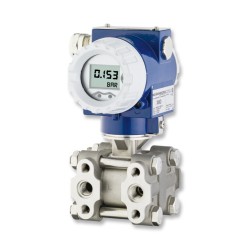 Overpressure is used to describe a condition where the pressure value has exceeded operational limits or a threshold pressure.
Overpressure is used to describe a condition where the pressure value has exceeded operational limits or a threshold pressure.
An Overpressure value may refer to an alarm condition on a process which warns an operator that a limit has been exceeded or triggers a switch which controls a pressure relief valve.
Overpressure may also refer to the maximum pressure value that a pressurised component can withstand without affecting operational performance.
 DPT100 Modbus RTU RS485 Differential Pressure Sensor - The DPT 100 is a high-accuracy differential pressure transmitter designed for fast test processes in leakage and flow measurement applications where rapid response time and high sampling rates are essential
DPT100 Modbus RTU RS485 Differential Pressure Sensor - The DPT 100 is a high-accuracy differential pressure transmitter designed for fast test processes in leakage and flow measurement applications where rapid response time and high sampling rates are essential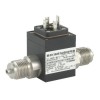 DMD331 Compact Differential Liquid Pressure Sensor - Wet wet differential pressure sensor with a high overpressure rating on both positive and negative pressure side for protection against damage.
DMD331 Compact Differential Liquid Pressure Sensor - Wet wet differential pressure sensor with a high overpressure rating on both positive and negative pressure side for protection against damage. DPT200 Pressurised Tank Level Differential Pressure Transmitter - Pressurised tank liquid level differential pressure cell transmitter for process plant storage.
DPT200 Pressurised Tank Level Differential Pressure Transmitter - Pressurised tank liquid level differential pressure cell transmitter for process plant storage. DPT200 High One Side Overload Differential Pressure Sensor - DP transmitter for measuring pressure difference between two pressure points which can tolerate up a very high overload pressure independently on either the positive or negative side port or both together at the same time.
DPT200 High One Side Overload Differential Pressure Sensor - DP transmitter for measuring pressure difference between two pressure points which can tolerate up a very high overload pressure independently on either the positive or negative side port or both together at the same time.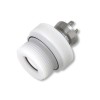 LMK351 High Overpressure Flush Level Transmitter - Flush capacitive ceramic pressure sensor for measuring corrosive and viscous liquid level from levels 0.4 metres of water up to 200 mH2O.
LMK351 High Overpressure Flush Level Transmitter - Flush capacitive ceramic pressure sensor for measuring corrosive and viscous liquid level from levels 0.4 metres of water up to 200 mH2O. 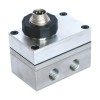 PD39X High Differential Pressure Transmitter - High pressure differential sensor with high over-pressure in scaleable differential ranges from 3 bar up to 300 bar differential.
PD39X High Differential Pressure Transmitter - High pressure differential sensor with high over-pressure in scaleable differential ranges from 3 bar up to 300 bar differential. PD39X Twin Absolute Digital DP Sensor - Digital pressure sensor with 3 separate channels for measuring P1, P2 and DP readings plus 2 temperature channels.
PD39X Twin Absolute Digital DP Sensor - Digital pressure sensor with 3 separate channels for measuring P1, P2 and DP readings plus 2 temperature channels. DMP 335 All Welded Stainless Steel Diaphragm Pressure Sensor - All welded stainless steel diaphragm pressure sensor for mobile hydraulics, refrigeration or oxygen applications. This pressure sensor is available in the ranges from 6 bar up to 600 bar gauge with a 4-20mA or 0-10Vdc output signal.
DMP 335 All Welded Stainless Steel Diaphragm Pressure Sensor - All welded stainless steel diaphragm pressure sensor for mobile hydraulics, refrigeration or oxygen applications. This pressure sensor is available in the ranges from 6 bar up to 600 bar gauge with a 4-20mA or 0-10Vdc output signal.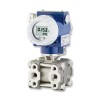 XMD Process Plant DP Cell Differential Pressure Transmitter - Rangeable DP Cell current loop process transmitter for monitoring differential pressures in a heavy duty process plant environment.
XMD Process Plant DP Cell Differential Pressure Transmitter - Rangeable DP Cell current loop process transmitter for monitoring differential pressures in a heavy duty process plant environment.
Overpressure Protection Types
On most manufacturer’s pressure sensor data sheets you will find an over-pressure or proof pressure rating. This is the maximum pressure that the pressure sensor will tolerate without damaging the diaphragm or putting it outside specification tolerances.
The overpressure or proof pressure rating is mainly a guideline for determining whether a pressure sensor will be protected when there is a system failure and a pressure is applied which is over and above the normal operating conditions.
Under-Ranging
 One design approach is to under use the range of a particular diaphragm rating e.g. use a 100 bar diaphragm to measure 50 bar effectively doubling the overpressure rating (e.g. PD39X). The main drawback of this method is that the accuracy and output sensitivity are compromised so the high output and linear sensing technologies such as semiconductor strain gauge tend to be favoured when using the down ranging method.
One design approach is to under use the range of a particular diaphragm rating e.g. use a 100 bar diaphragm to measure 50 bar effectively doubling the overpressure rating (e.g. PD39X). The main drawback of this method is that the accuracy and output sensitivity are compromised so the high output and linear sensing technologies such as semiconductor strain gauge tend to be favoured when using the down ranging method.
Mechanical Stops
 A more complex approach is to incorporate mechanical stops behind the diaphragm to prevent the diaphragm from being over-stressed. This leads to a more expensive and bulkier mechanical design. A sensing technology that has a large enough degree of travel is also required in order to make setting the distance of the mechanical stop to the correct over-pressure rating practical. Alternatively for sensing technology that does not have a high degree of mechanical movement it can be integrated into an oil filled capsule with a non-sensing diaphragm (e.g. XMD) that will yield in an over pressure condition to allow enough movement in another non-sensing diaphragm so that it bottoms out onto a mechanical stop and thus prevents any further increase in pressure and protects the sensing diaphragm.
A more complex approach is to incorporate mechanical stops behind the diaphragm to prevent the diaphragm from being over-stressed. This leads to a more expensive and bulkier mechanical design. A sensing technology that has a large enough degree of travel is also required in order to make setting the distance of the mechanical stop to the correct over-pressure rating practical. Alternatively for sensing technology that does not have a high degree of mechanical movement it can be integrated into an oil filled capsule with a non-sensing diaphragm (e.g. XMD) that will yield in an over pressure condition to allow enough movement in another non-sensing diaphragm so that it bottoms out onto a mechanical stop and thus prevents any further increase in pressure and protects the sensing diaphragm.
Pressure Relief
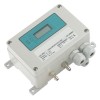 Introducing pressure relief into the pressure sensor design is another elaborate way to protect the sensing diaphragm from over-pressure (e.g. DPS). Either self activating mechanical pressure relief valves or electrically activated valves controlled by the pressure sensor output can be utilised to vent and isolate the pressure sensor from an over pressure condition.
Introducing pressure relief into the pressure sensor design is another elaborate way to protect the sensing diaphragm from over-pressure (e.g. DPS). Either self activating mechanical pressure relief valves or electrically activated valves controlled by the pressure sensor output can be utilised to vent and isolate the pressure sensor from an over pressure condition.
Help
Accuracy over 100% of range
I just want to learn that if I have a pressure transducer with a 0 – 250 psi range, can I use it for higher pressures such as 310 psi? Can you advise whether it is ok or the transducer is not going provide the correct reading, as I have used it beyond its range?
Most pressure transducers are not calibrated beyond 100% full scale so you cannot rely on the accuracy of any readings over 100%. Also if the over-pressure rating has been exceeded the accuracy below 100%FS may have been affected.
Related Help Guides
- What is difference between working, burst and over pressure
- Symptons and Causes of Damage to Pressure Transducer Diaphragms
- Selecting a pressure range for optimal service life and accuracy
- Protecting a pressure sensor from high pressure spikes
